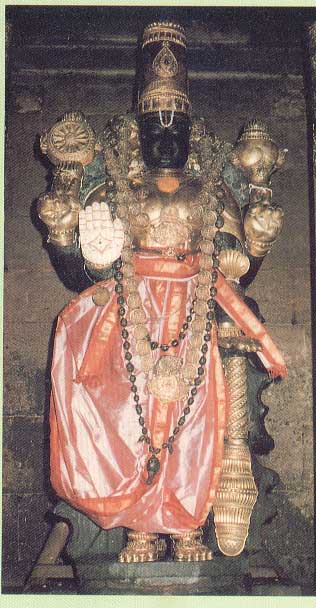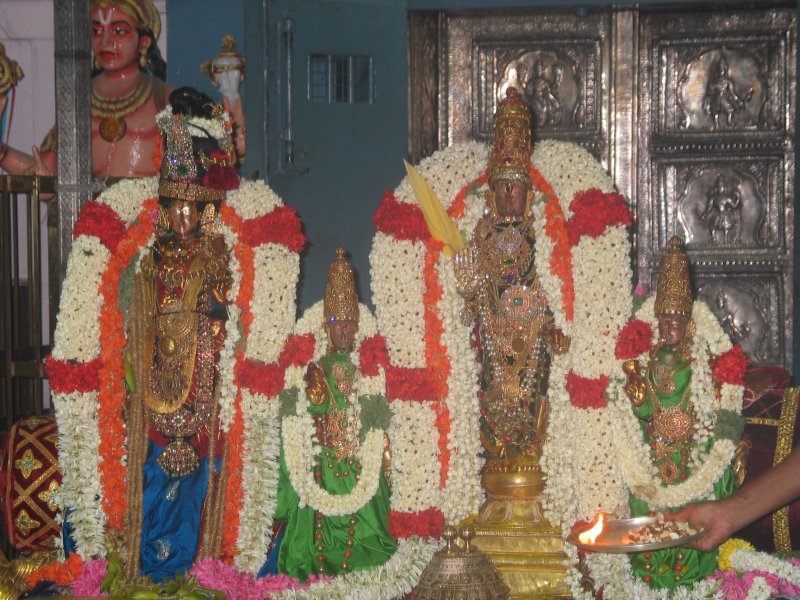GITA 11.10
Among the Acharyas of Sri Vaishnava sampradaya, Swami Vedanta Desika has a special place. He had visited many Divya Desams and composed stotrams on the Lord there. He had composed 28 stotrams. Of those, Vairagya Panchakam [वैराग्य पंचकं வைராக்ய பஞ்சகம்] is one. In just Five slokas, he had expressed his contempt for worldly life, detachment to worldly properties and wealth and attachment only to the Lord's divine Feet as his wealth. It praises the Lord of Kanchi, Sri Devaraja Perumal. He was living in this Kshetram and worshipping the Lord. He had a friend Swami Vidyaranya, who was quite wealthy; Vidyaranya through an emissary, told Swami Desika, that he need not suffer in poverty, and invited him to come to him when he would arrange enough wealth for a comfortable life. Swami Desika was least interested in worldly wealth and he said his property was atop Hasthigiri. Expressing this in a sloka, he composed Vairagya Panchakam. Swami Desika says that there is no property he had accumulated nor he had any hereditary wealth. He further says that it did not mean he had no wealth. His wealth was atop Hasthigiri. This wealth was stored by lord Brahma when the Lord Sri Varadaraja appeared from the Yagna performed by lord Brahma. All other wealth might decay or be destroyed, but the Wealth atop Hashigiri would ever remain. A mother does not get disgusted at her child's excretions, but fondly cleanses the child. Swami Desika says that the Lord is in him [as in all others]; He is not getting disgusted to remain in our body, which has all sorts of disgustful waste matter. The Lord Sri Varanasaila Natha is inside. Swami Desika asks the Lord how he liked to remain in this disgusting surrounding? Especially, how He is able to leave Vaikuntam and Tirupparkadal [Milk Ocean] and reside in him? Swami Desika further says that considering the Lord's extreme care for him, he would also not like to be in Vaikuntam; but be serving the Lord of Kanchi. This is a promise, he says. Tondaradipodi Alwar, Tiruppanalwar and Hanuman, have expressed their desire to remain here in the service of the Lord, rather than going to Vaikuntam. Visiting Hasthigiri and enjoying the splendour of processions of the Lord, is a gift. Today's [9th October 2008 and incidentally, Vijaya Dasami and Swami Desika's birthday] we can have a treat of the processions of the Lord.
 |
| THE LORD DESCENDING THE STEPS OF HASTHIGIRI |
The Lord descends the steps to bless us and thereby lift us up to His place. The Lord graces with enormous ornaments and robes. Hasthigiri means the Lord was worshipped by an elephant. In Kruta yug, lord Brahma worshipped. In Treta yug, elephant Gajendra worshipped. In Dwapara yug, Brahaspati worshipped the Lord on the banks of river Vegavati, to get his curse removed. In Kali yug, the Lord was worshipped by Anantha or Adisesha.
We will now see sloka 9 of Chapter 11 of Gita. In the first Four slokas, Arjuna expressed his desire to see the Lord with all His auspicious qualities and boundless wealth. In the next Four slokas, ie. slokas 5,6,7 and 8, Sri Krishna agreed to grant Arjuna the rare vision of seeing Viswaroopam; and He assured to grant divine eyes to see His magnificent image, which would be impossible to see by normal eyes. In the next Five slokas, from sloka 9 to sloka 13, Sanjaya tells King Dridarashtra. Sanjaya is explaining the happenings on the battlefield to the blind king at his palace. Sanjaya explains how the Lord showed His Viswaroopam, very precisely in Five slokas. From sloka 14, Arjuna views the Viswaroopam and praises the Lord. Arjuna mentions whatever he saw and praises the Lord. Now sloka 9:
sanjaya uvaca
evam uktva tato rajan
maha-yogesvaro harih
darsayam asa parthaya
paramam rupam aishvaram
"Sanjaya said: O King, having spoken thus, the Supreme Lord of all mystic power, the Personality of Godhead, displayed His universal form to Arjuna."
| THE VISHWAROOPAM |
Swami Koorathalwan asked the Lord as to which place He liked to reside - in the hearts of common people? Or, in Vedas? Or, in the heart of Nammalwar? Or, atop Hasthigiri? He himself answers this saying that the Lord liked being on top of Hasthigiri; because, being available in Hasthigiri, the Lord was seen by Alwar; was seen by common people; Hasthigiri itself was Vedas. Normally, we experience goosebumps [மயிர் கூச்செறிதல்], when we touch desired objects. Hasthigiri is liked by the Lord. His feet are like an inverted lotus flower. As the Lord stands on Hasthigiri, place of His liking, the Lord experiences goosebumps; and they resemble the fibres on the stem of the Lotus flower! We will see more places related to Sri Devaraja and Swami Ramanuja, within Kanchi.
(continued)












